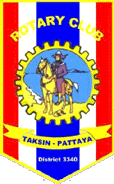- HEADLINES [click on headline to view story]:
-
Chateau visit in Bordeaux
-
When lawyers “pull strings” - watch out!
|
|
Chateau visit in Bordeaux
by Ranjith Chandrasiri
It’s by no accident that Bordeaux has been the
world’s foremost fine wine producing region for nearly a millennium. For
a start, nature has provided Bordeaux with the perfect setting; the
Atlantic-influenced climate is mild with steady humidity, occasional
spring frosts and lingering Indian summers. The Landes Forest to the south
not only provides a breathtaking backdrop but also acts as a versatile
windbreak.
If you are a serious wine lover and want to discover
some fascinating wines, you should take a tour through Bordeaux - the
world’s leading wine region. Over five thousand wine chateaux in 56
appellations, many different grape varieties and vinification methods give
the serious connoisseurs, as well as the novice, plenty of opportunities
to explore in to the intriguing world of wines. In order to discover
fully, you need to visit the entire Bordeaux region, as there is an
infinite variety of wines being produced in different appellations in the
region. Along the way, you will even have the opportunity to visit some of
the mysterious ancient villages and enjoy the breathtaking views of the
countryside. You might even develop an appetite for such delicacies as
foie gras and bordelaise dessert canelais on the way.
 Ranjith
Chandrasiri with Jean-Bernard Greni้, the winemaker & owner of
prestigious Chโteau Ang้lus in St Emilion, Bordeaux. Ranjith
Chandrasiri with Jean-Bernard Greni้, the winemaker & owner of
prestigious Chโteau Ang้lus in St Emilion, Bordeaux.
There can be no better place to start the journey than
St-Emilion, the picturesque medieval town on the Right bank. St-Emilion is
Bordeaux’s most historic wine region, it’s history traced back to
Gallo-Roman times. Walking down the steep cobbled streets of St-Emilion is
a delightful experience. You would think you were entering the Middle
Ages. It is a charming stone village perched on a hilltop, Romanesque
church carved out of a rock, and other historical buildings are
outstandingly beautiful. From the hilltop, a spectacular panorama of the
surrounding countryside unfolds above the enchanting town.
St-Emilion was established as a wine region long before
M้doc. However, situated to the east of the Garonne and Dordogne
rivers on the Right bank, it was geographically isolated and remained the
poor cousin to the more affluent M้doc and Graves on the Left bank.
This was highlighted by the absence of the Right bank wines from the
famous 1855 classification, which listed wines only from the M้doc
and Chโteau Haut-Brion in Graves.
The revival of St Emilion first occurred in the 1930s
with the demolition of geographical boundaries and recognition of Pomerol
as an independent appellation. Further momentum was added with the
creation of 1955 classification for St-Emilion wines. St-Emilion has a
larger but more flexible classification, revised every decade (more or
less) through an official tasting. This has become a motivating force for
the wine makers, providing healthy competition that has kept St-Emilion
bustling in recent years. The wines are divided in to three categories:
Premiers Grands Crus Class้s “A”, Premiers Grands Crus Class้s
“B”; and Grands Crus Class้s.
During a visit to Bordeaux in the last harvesting
season, my wife Chitra and I took the opportunity to explore the St-Emilion
region. We spent days visiting some of the best chโteaux in the
region, discovering fascinating wines and meeting the people who make
them. The owners kindly involved us in harvesting and allowed us tastings
from the barrels. It was an idyllic time that we will not easily forget.
Two particular chโteaux that we visited in St- Emilion, Chโteau
Ang้lus and Chโteau Laroque were particularly outstanding for
the quality of wines they produce and the owners’ commitment to their
profession. In the St-Emilion classification review that took place in
1996, the promotion of Chโteau Ang้lus to the prestigious
Premier Grand Cru Class้ and the elevation of Chโteau Laroque
to Grand Cru Class้ status confirm their commitment to outstanding
quality.
Just half a mile from the famous St-Emilion bell tower,
on the renowned “pied de c๔te” (foot of the hill), Chโteau
Ang้lus is the outcome of an impassioned commitment made over four
generations by the Bouard de Laforest family. The property owes its name
to the plot of land where the Angelus bell can be heard from all the three
local churches simultaneously. At the beginning of the century, this plot
of seven acres was acquired by Maurice de Bouard de Laforest, who already
owned a neighboring vineyard, chโteau Mazarat which had been in the
family since 1850. Through generations, adjacent plots were acquired and
expanded to the magnificent property it is today, 58 acres cultivated as a
single unit. Hubert de Bouard de Laforest and his cousin Jean - Bernard
Greni้ manage the property and personally oversee the creation of Chโteau
Ang้lus Premier Grand Cru Class้ that capture the very essence
of their land.
The land of Chโteau Ang้lus is blessed with
unique limestone clay soil on the upper slopes and sandy limestone clay on
the lower hillside. The vineyard covers a superb natural landscape of
hills and plateaux with attractive mosaic of vines stretching out as far
as the eye can see. The vines with an average age of 30 years are
cultivated in the traditional manner and partially left unweeded. Buds are
removed and then in summer the leaves are cleared away to let the sun
through allowing the grapes to ripen slowly and completely over a long
period until harvest. Centuries of experience have proved that the
limestone clay soil is ideal for the Merlot grape. In the Chโteau
Ang้lus vineyard, Merlot accounts for 50% of the vine stock,
Cabernet Franc 47%, and a small percentage of Cabernet Sauvignon that make
up the unique Ang้lus blend.
Without a dedicated owner and a talented winemaker,
even the chโteaux with the best terroirs will not make good wine.
Oenologist Hubert de Bouard de Laforest and Jean - Bernard Greni้
are dedicated wine makers who pay meticulous attention to every detail of
wine making. Harvesting is done completely manually with the grape
selection being made first in the vineyard and then on the selection
tables in the chโteau. Stalks are removed 100% and only the best of
the best fruits are selected for the premier grand cru wine. Wine is
fermented in stainless steel vats with a temperature control system before
maceration. Then the wine is matured for 18 to 22 months in brand new oak
casks. As the soft-spoken monsieur Greni้ patiently explains, you
can’t hurry making good wines. It’s almost two years after the harvest
that the wine will be ready for bottling. After finning with egg whites in
the traditional manner, wine is bottled in the chโteau, a practice
referred to as “Mis en Bouteille au Chโteau”. Chโteau Ang้lus
also has a second wine - Carillon de l’ Ang้lus with a small
production of about 20,000 bottles per vintage.
On our visit to Chโteau Ang้lus, Monsieur
Greni้ received us with a warm welcome, cutting short his lunch
break due to his busy schedule during harvest. We strolled the vineyard
taking in the sweeping view while listening to Monsieur Greni้
explaining the art of making fine wines. After a tour of the chโteau,
we were treated to an exclusive tasting of the finest Chโteau Ang้lus
wines. It was a turning point for me, the beginning of a love affair with
Bordeaux and it’s fine wines.
We tasted vintage 2000 off the barrel and 1998, which
was simply outstanding. A unique blend of 66% Merlot and 34% Cabernet
Franc; a very deep, well-structured wine with excellent tannins and aroma.
Vintage 1995 - This wine is strongly coloured, with
hints of sugared plums, blackberry jam and spices. High percentage of
Cabernet Franc over 50% brings with it minty tannins full of freshness,
elegance and complexity with a promise to have longevity as long as 2025
and beyond although ready for drinking now.
1996 - is the first vintage of Chโteau Ang้lus
to bear the status of “Premier Grand Cru Class้”. The wine has a
rich colour with classic structure and a dazzling fruity fragrance.
Good news for the wine lovers in Pattaya (and those who
can afford it) is that the Royal Cliff wine list (arguably one of the best
wine lists in Thailand) will add some of the outstanding vintages of Chโteau
Ang้lus to its prestigious collection.
Let me take you to Chโteau Laroque - my other
love in St -Emilion on our next chโteau visit.
Ranjith Chandrasiri is the resident manager, Royal
Cliff Grand, Royal Cliff Beach Resort, Pattaya, Thailand. Email [email protected]
When lawyers “pull strings” - watch out!
Story and photos by Peter Cummins
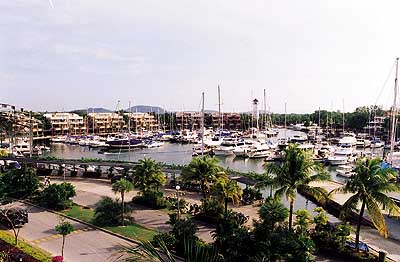
The
Phuket Boat Lagoon: what a place for a regatta!
When I am in a “spot of bother” - which is
reasonably often - of course I try to sort the problem(s) out myself. If
it becomes too difficult, ah well, I go and try to find a lawyer ‘to
pull a few strings’ on my behalf. To witness a lawyer - any lawyer -
‘pulling a few strings’ can be a chastening - if not a downright
awesome - experience. Imagine, then, for a moment, being around some 20
lawyers and legally oriented people - all “pulling strings”.
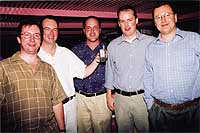 “Wooden
spooners” all: boss-man Simon on the right could really hone in on the
supplies with his GPS. “Wooden
spooners” all: boss-man Simon on the right could really hone in on the
supplies with his GPS.
Actually, that is not exactly the way it sounds.
Recently, the highly-reputable international law firm of Allen and Overy
brought some 20 staff from Hong Kong, Singapore and Tokyo to join a big
contingent of Bangkok-based staff, to join forces with an even-larger
number of their clients in an international regatta sailed off Phuket.
These latter represented some of the region’s major bankers, financiers
and investment tycoons from the same four Asian cities. The group
proceeded to Phuket where they did not pull strings; rather, they pulled
ropes (nautical term, ‘sheets’), seeking to outwit each other out on
the sea, for a change, rather than in a courtroom or in the higher
echelons of the corporate world.
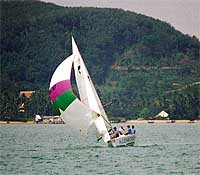 A
spinnaker run was quite a challenge, too. A
spinnaker run was quite a challenge, too.
The occasion was the Second Allen and Overy Asian
Sailing Challenge, held out off the Phuket Boat Lagoon and raced in Farr
Platu 25s and a range of Sunsail yachts, organized by Simon James, the
Phuket custodian and sailing trainer ‘par excellence’ of Sunsail
Charters - the world’s biggest and best yacht charter group, found in
every location that is worth visiting.
The winds were not great, but there was enough wind to
test the sailors, and the race management, under Simon’s experienced
hand, was excellent. Allen and Overy-led teams won the day but it was not
the Bangkokians who triumphed; rather, one of the few ladies competing,
Melissa Faye from the A & O Singapore Office, who was the regatta’s
“outstanding sailor”, winning the honours on a Sunsail Oceanis 328,
“La Pinelle”. One would have thought that it would have been more
appropriate for Melissa to sail the Oceanis 44, “Melissa”; but then,
she may not have won.
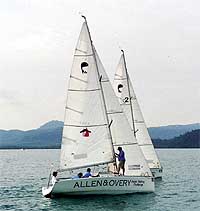 Regardless
of who won, the racing was close. Regardless
of who won, the racing was close.
The Platu prize went to Andrew Jeffries’ team
comprising, of course, skipper Andrew, A & O (Hong Kong), Gareth Spero,
Barclays Capital, (Hong Kong) and, to maintain the Hong Kong domination,
Gareth Williams, Vigers HK Limited.
The Oceanis prize also went to A & O’s Hong Kong
Office, with Andrew Harrow driving the Oceanis 39 and his team of t(r)usty
lieutenants, Sarah Pearson, CSFB (Tokyo), Rob Everett, Merrill Lynch (Hong
Kong), Andrew Ferguson, HSBC (Hong Kong), Chris Flosi, Barclays Capital
(Hong Kong) and Tony Corcoran, ABN AMRO (Hong Kong).
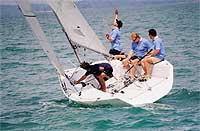 A
& O Asian Sailing Challenge: another way to “pull strings”. A
& O Asian Sailing Challenge: another way to “pull strings”.
But, wait: it was not all over(y)! Where was Bangkok A
& O boss man, Simon Makinson - also reputed down Pattaya way as a
“rising star” of yacht racing? Well, Simon and David Sedgley, as the
host office, collected the “Wooden Spoon” Award.
 Life
was not all that bad on a Sunsail charter. Life
was not all that bad on a Sunsail charter.
They received the coveted prize, “The GPS beer finder
navigation device,” because they logged the most requests for beer - on
board, on shore, on the bus...! Their Oceanis 350 team included Charles
Rubin, Lehman Brothers (Bangkok), Patrick Kaye, Lehman Brothers (Bangkok)
and Jason Dunn, Lehman Brothers (Tokyo).
A great time was had by all and, already, this
correspondent has been informed, many are busy “pulling strings”, so
they can return to Phuket to “pull ropes”.
|
|
|
|
News | Business News | Features | Columns | Letters | Sports | Auto Mania
Kid's Corner | Who’s Who | Travel | Our Community | Dining Out & Entertainment
Social Scene | Classifieds | Community Happenings | Books Music Movies
Club in Pattaya | Sports Round-Up
E-mail: [email protected]
Pattaya Mail Publishing Co., Ltd.
370/7-8 Pattaya Second Road, Pattaya City, Chonburi 20260, Thailand
Tel.66-38 411 240-1, 413 240-1, Fax:66-38 427 596
Copyright © 2002 Pattaya Mail. All rights reserved.
This material may not be published, broadcast, rewritten, or redistributed.
|
|
|


 Ranjith
Chandrasiri with Jean-Bernard Greni้, the winemaker & owner of
prestigious Chโteau Ang้lus in St Emilion, Bordeaux.
Ranjith
Chandrasiri with Jean-Bernard Greni้, the winemaker & owner of
prestigious Chโteau Ang้lus in St Emilion, Bordeaux.
 “Wooden
spooners” all: boss-man Simon on the right could really hone in on the
supplies with his GPS.
“Wooden
spooners” all: boss-man Simon on the right could really hone in on the
supplies with his GPS. A
spinnaker run was quite a challenge, too.
A
spinnaker run was quite a challenge, too. Regardless
of who won, the racing was close.
Regardless
of who won, the racing was close. A
& O Asian Sailing Challenge: another way to “pull strings”.
A
& O Asian Sailing Challenge: another way to “pull strings”. Life
was not all that bad on a Sunsail charter.
Life
was not all that bad on a Sunsail charter.

